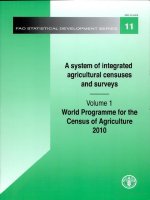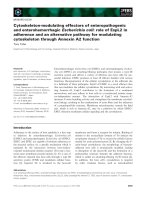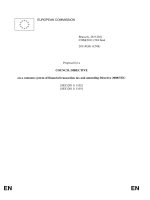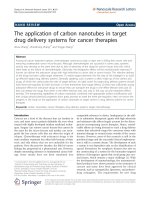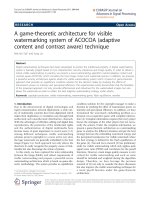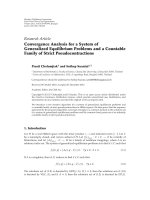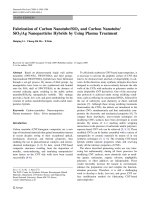Hybrid fiber reinforced polymer (FRP) system of carbon FRP laminate and sprayed glass FRP for strengthening reinforced concrete beams
Bạn đang xem bản rút gọn của tài liệu. Xem và tải ngay bản đầy đủ của tài liệu tại đây (2.96 MB, 188 trang )
HYBRID FIBER REINFORCED POLYMER (FRP) SYSTEM OF CARBON FRP
LAMINATE AND SPRAYED GLASS FRP
FOR STRENGTHENING REINFORCED CONCRETE BEAMS
By
NINGFENG LIANG
A DISSERTATION PRESENTED TO THE GRADUATE SCHOOL
OF THE UNIVERSITY OF FLORIDA IN PARTIAL FULFILLMENT
OF THE REQUIREMENTS FOR THE DEGREE OF
DOCTOR OF PHILOSOPHY
UNIVERSITY OF FLORIDA
2006
UMI Number: 3228772
UMI Microform 3228772
Copyright 2007 by ProQuest Information and Learning Company.
All rights reserved. This microform edition is protected against
unauthorized copying under Title 17, United States Code.
ProQuest Information and Learning Company
300 North Zeeb Road
P.O. Box 1346
Ann Arbor, MI 48106-1346
Copyright 2006
by
NINGFENG LIANG
To my parents and Hong
ACKNOWLEDGMENTS
First, I would like to thank Dr. Andrew Boyd, my advisor, for his constant support
and guidance in the entire course of this research. The assistance by all the other
committee members to form the research content is truly appreciated as well.
Second, without the collaboration with those lab and department staffs, it would be
impossible for this research to be finished. Specifically, my sincere thanks go to JJ,
Chuck, Danny, George and Tony. I really enjoyed working with all of them.
Third, I really appreciate the generous donation of the CFRP laminates by Sika.
Ron made sure the materials arrived on time and in good shape. The same appreciation
also goes to MVP for donating the spraying equipment, resin and glass fiber. Gregg
provided invaluable technical assistance in operating the spraying equipment.
Last, but not least, the friendship shown by Yanjun, Huamin, Xiaoyan, Yu Chen
and Jeff will keep me cherishing the time I spent at the University of Florida for the rest
of my life. Their encouragement and help made the days of hard work enjoyable.
iv
TABLE OF CONTENTS
page
ACKNOWLEDGMENTS ................................................................................................. iv
LIST OF TABLES........................................................................................................... viii
LIST OF FIGURES ........................................................................................................... ix
LIST OF ACRONYMS .................................................................................................... xii
ABSTRACT..................................................................................................................... xiii
CHAPTER
1
INTRODUCTION ........................................................................................................1
General..........................................................................................................................1
Research Objectives......................................................................................................4
Thesis Structure ............................................................................................................5
2
LITERATURE REVIEW .............................................................................................6
FRP Materials ...............................................................................................................6
Bond Strength of FRP-concrete Joint ...........................................................................9
Flexural Strengthening of RC Beams .........................................................................12
Brief History........................................................................................................12
Failure Modes......................................................................................................15
Flexural Strength Models ....................................................................................18
Shear Strengthening of RC Beams .............................................................................20
Introduction .........................................................................................................20
Failure Modes......................................................................................................23
Shear Strength Models ........................................................................................23
Sprayed FRP ...............................................................................................................24
Design Guideline ........................................................................................................26
Flexural Strengthening ........................................................................................26
Shear Strengthening.............................................................................................28
3
MATERIAL PROPERTIES .......................................................................................30
Preparation of Sprayed FRP .......................................................................................31
v
Component Materials ..........................................................................................31
Spraying Equipment ............................................................................................32
Spraying Process .................................................................................................34
Effects of Specimen Orientation and Thickness.........................................................36
Specimen Preparation and Testing Setup ............................................................36
Results and Discussion ........................................................................................39
Effects of Fiber Length...............................................................................................39
Specimen Preparation..........................................................................................39
Results and Discussion ........................................................................................40
Effects of Fiber Content..............................................................................................43
Specimen Preparation..........................................................................................43
Results and Discussion ........................................................................................43
Concrete......................................................................................................................44
Steel ............................................................................................................................45
Carbon Fiber Reinforced Polymer (CFRP) Laminate ................................................45
4
BEAM STRENGTHENING WITH CFRP/SPRAYED GFRP HYBRID SYSTEM.48
Introduction.................................................................................................................48
Preparation of Reinforced Concrete Beams ...............................................................48
Beam Formwork..................................................................................................48
Beam Casting.......................................................................................................49
Beam Testing Program ...............................................................................................51
Concrete Beam Design ........................................................................................51
Strengthening Plan...............................................................................................52
Program Objectives .............................................................................................53
Strengthening Details ..........................................................................................54
Simulated Steel Corrosion...................................................................................56
FRP Strengthening of Beams ..............................................................................58
Load Test ....................................................................................................................62
Test Setup and Procedure ....................................................................................62
Instrumentation....................................................................................................64
Results and Discussion ...............................................................................................66
Failure Modes......................................................................................................70
Energy Absorption...............................................................................................76
Beam Deflection Profile ......................................................................................79
Steel Strain...........................................................................................................83
CFRP Strains .......................................................................................................85
Sprayed GFRP Strains.........................................................................................87
Effects of Reinforcement.....................................................................................89
5
THEORETICAL ANALYSIS ....................................................................................91
Classical Beam Analysis.............................................................................................91
Material Models...................................................................................................92
Moment-Curvature Analysis ...............................................................................94
Calculation of Mid-span Deflection ..................................................................101
vi
Finite Element Analysis............................................................................................102
Results and Discussion .............................................................................................104
Load and Deflection ..........................................................................................104
Material Strains .................................................................................................110
Steel strains ................................................................................................111
CFRP strains...............................................................................................115
Sprayed GFRP strains ................................................................................117
6
DESIGN GUIDELINES...........................................................................................123
Notation ....................................................................................................................124
Design Procedure......................................................................................................126
Design Example........................................................................................................128
7
REPAIR OF A CONCRETE BRIDGE WITH CFRP/SPRAYED GFRP HYBRID
SYSTEM...................................................................................................................133
Introduction...............................................................................................................133
Background...............................................................................................................133
Bridge Conditions Before Repair .............................................................................135
Strengthening Design................................................................................................137
Load Test before Repair ....................................................................................137
Materials ............................................................................................................138
Flexural Strength ...............................................................................................138
Shear Strength ...................................................................................................139
Installation of CFRP-sprayed GFRP System............................................................141
Environmental Issues and Protection ................................................................141
Repair Work ......................................................................................................144
8
CONCLUSIONS AND RECOMMENDATIONS ...................................................151
APPENDIX
MATHCAD PROGRAM FOR THE CLASSICAL BEAM ANALYSIS.......................154
LIST OF REFERENCES.................................................................................................165
BIOGRAPHICAL SKETCH ...........................................................................................173
vii
LIST OF TABLES
page
Table
2-1. Typical tensile properties of fibers used in FRP systems.............................................7
2-2. Typical mechanical properties of GFRP, CFRP and AFRP composites......................8
3-1. Material properties of resin.........................................................................................31
3-2. Material properties of glass fiber................................................................................32
3-3. Typical laminate mechanical properties (Ortho polyester). .......................................32
3-4. Effect of specimen orientation....................................................................................39
3-5. Effect of sprayed FRP thickness.................................................................................39
3-6. Effect of fiber length on material properties of sprayed FRP.....................................40
3-7. Effects of fiber content on material properties of sprayed FRP. ................................43
3-8.Tensile properties of reinforcing steel .........................................................................45
3-9. Properties of CFRP.....................................................................................................46
4-1. Beam configuration. ...................................................................................................52
4-2. Summary of beam test results.....................................................................................67
5-1. Theoretical beam results...........................................................................................105
6-1. Design nominal load-carrying capacity of strengthened beams. ..............................132
7-1. Materials properties-bridge repair ............................................................................138
7-2. Nominal strength of bridge girders...........................................................................141
viii
LIST OF FIGURES
page
Figure
1-1. Typical flexural strengthening scheme for RC beams with FRP laminate...................2
2-1. Bond test. . ..................................................................................................................10
2-2. A Typical flexural strengthening scheme for a RC beam with FRP laminate. ..........12
2-3. Failure modes of beams FRP strengthened in flexure................................................16
2-4. Shear strengthening.. ..................................................................................................20
3-1. Spraying equipment....................................................................................................33
3-2. Geometry of testing specimen. ...................................................................................36
3-3. Specimen layout on sprayed FRP panel. ....................................................................37
3-4. Sprayed FRP tensile test setup....................................................................................38
3-5. Typical stress-strain curve from sprayed FRP tensile test..........................................38
3-6. Effects of fiber length.. ...............................................................................................41
4-1 Partial assembly of a beam form. ................................................................................49
4-2. Beam casting site layout. ............................................................................................50
4-3. Concrete truck delivering concrete to wooden forms.................................................51
4-4. Concrete beam details.................................................................................................52
4-5. Beam strengthening schemes. ....................................................................................55
4-6. Simulated damages. . ..................................................................................................57
4-7. Sandblasting concrete beam surfaces. ........................................................................58
4-8. Setup for CFRP laminate bonding..............................................................................59
4-9. Application of sprayed GFRP. ...................................................................................61
ix
4-10. Beam lab testing. .....................................................................................................63
4-11. Instrumentation on reinforcement steel. ...................................................................65
4-12. Instrumentation on beams strengthened with CFRP / sprayed FRP hybrid system.
..................................................................................................................................65
4-13. Undamaged beam failure modes. . ...........................................................................72
4-14. Damaged beam failure modes. ................................................................................74
4-15. Load–deflection curves of undamaged beams..........................................................77
4-16. Load-deflection curves of damaged beams. . ...........................................................78
4-16. Load-deflection curves of damaged beams. .............................................................78
4-17. Deflected shapes at beam failure. .............................................................................79
4-18. Variation of support rotation of undamaged beams. ................................................81
4-19. Variation of support rotation of damaged beams. ....................................................82
4-20. Steel strains...............................................................................................................84
4-21. CFRP strains in A-2 and A-4....................................................................................86
4-22. CFRP strains in B-2, B-4 and A-4............................................................................86
4-23. SGFRP strains in A-3 and A-4. ................................................................................88
4-24. Sprayed GFRP strains in B-2, B-4 and A-4. ............................................................89
5-1. Material models. . .......................................................................................................93
5-2. Flexural analysis of RC section retrofitted with the hybrid FRP system. ..................97
5-3. Graphic illustration for mid-span deflection calculation..........................................101
5-4. Geometric representation of two-dimensional finite element model. ......................102
5-5. Meshed ADINA model.............................................................................................104
5-6. Beam load-deflection curves. . .................................................................................107
7-1. University boulevard bridge (NBI # 724214)...........................................................134
7-2. Vehicle weight limit for University boulevard bridge..............................................134
7-3. A beam after removal of loose concrete cover. ........................................................136
x
7-4. Corroded reinforcement............................................................................................136
7-5. Cross section of strengthened bridge........................................................................139
7-6. Containment for resin drum......................................................................................142
7-7. Work platform. .........................................................................................................143
7-8. Turbidity barrier and plastic sheeting.......................................................................144
7-9. Patched beam............................................................................................................145
7-10. Cleaning of CFRP laminate surface .......................................................................146
7-11. Two installed CFRP laminates on a beam..............................................................147
7-12. Spray of another layer on hardened GFRP.............................................................149
7-13. Rollout of newly sprayed GFRP.............................................................................149
xi
LIST OF ACRONYMS
ACI: American Concrete Institute
CFRP: Carbon Fiber Reinforced Polymer
FRP: Fiber Reinforced Polymer
GFRP: Glass Fiber Reinforced Polymer
SGFRP: Sprayed Glass Fiber Reinforced Polymer
xii
Abstract of Dissertation Presented to the Graduate School
of the University of Florida in Partial Fulfillment of the
Requirements for the Degree of Doctor of Philosophy
A HYBRID FIBER REINFORCED POLYMER (FRP) SYSTEM OF CARBON FRP
LAMINATE AND SPRAYED GLASS FRP FOR STRENGTHENING REINFORCED
CONCRETE BEAMS
By
Ningfeng Liang
August, 2006
Chair: Andrew J. Boyd
Cochair: H. R. Hamilton
Major Department: Civil and Coastal Engineering
This work is aimed to combine the potential of CFRP laminates in flexural
strengthening of reinforced concrete (RC) beams and that of sprayed glass FRP (GFRP)
in shear strengthening to form a better hybrid FRP system. Only the flexural
strengthening effects of the hybrid system were investigated in this study.
The sprayed GFRP also contributes to the flexural capacity of the strengthened
beams. Tension tests were performed to determine its tensile properties, in terms of
tensile strength and stress-strain relationship. These properties were shown to be affected
by glass fiber length and content, but not by the orientation and thickness of the
specimens.
Eight 2.8 meter reinforced concrete (RC) beams with adequate reinforcing steel
were cast. The reinforcing steel and concrete of some beams were then artificially
damaged to simulate steel corrosion and related concrete spalling usually occurred to
xiii
real-world RC beams. These beams were repaired with FRP in various configurations
including the hybrid system and tested in lab by a three-point loading setup. The results
indicate that the hybrid system improved the load-carrying capacity of the beams but
failed mostly in CFRP laminate debonding, a premature failure mode.
A classical RC beam analysis and a 2-D finite element analysis were performed to
predict the behavior of the strengthened beams. The results agree well with the
experimental results in terms of load-carrying capacity.
With the ‘plane section’ assumption and the ACI design guide for CFRP flexural
strengthening, the effects of the sprayed GFRP were developed for possible incorporation
into the existing design guide. The resulting design of the hybrid system was shown to be
conservative.
A real-world case study of the hybrid system revealed the issues that have to be
addressed before the system could be used effectively. It also showed some technical
difficulties related to the spraying operation.
xiv
CHAPTER 1
INTRODUCTION
General
In developed countries like the United States, Japan and those in Europe, there are
many buildings and bridges that were constructed during the years immediately following
World War II. Today, these structures are more than sixty years old so it is not surprising
that some parts of the building codes used to design these structures have changed
dramatically over the years due to a deeper understanding of the behavior of structures
under various loading conditions. Exposure to aggressive environmental agents and
accidental events throughout this long period of service life also caused severe damage
and deterioration in many structures. Moreover, functional changes to old buildings, or
increased loading due to heavier vehicles on bridges, resulted in a demand for necessary
structural modifications. One obvious option, replacing the deficient structures with new
ones, is usually economically prohibitive, time consuming and even unviable. For
instance, the shutdown of an outdated but crucial bridge in a busy highway network for
replacement may well cause more problems than it solves. Therefore, the other option of
rehabilitating or upgrading these structures to modern standards becomes the only
possibility under certain situations, especially for load-carrying components such as
beams and columns where strengthening is necessary to provide much needed loadcarrying capacity.
In the early 80’s, steel plates were often used to strengthen flexural members by
bonding such plates to the underside of the members. Significant improvement in
1
2
ultimate flexural strength and ductility can be achieved in this way. However, the
difficulty inherent in handling heavy steel sections and their susceptibility to corrosion
disqualified steel as the preferred candidate for such strengthening in practical
applications. To overcome these problems, researchers have been investigating the
applicability and effectiveness of fiber reinforced polymers (FRP), in lieu of steel, in
structural strengthening since the early 90’s. Figure 1-1 shows a typical FRP flexural
strengthening scenario where Carbon Fiber Reinforced Polymer (CFRP) plates (strips or
sheets) are bonded to the underside of a beam using epoxy resin.
FRP Laminate
Figure 1-1. Typical flexural strengthening scheme for RC beams with FRP laminate.
FRP can be divided into three groups by fiber types, namely carbon FRP (CFRP),
aramid FRP (AFRP), and glass FRP (GFRP). Of the three, CFRP and GFRP are the most
commonly used while AFRP is rare due to its relatively poor long term creep behavior.
CFRP is superior in terms of strength and stiffness but is also expensive, while GFRP, on
the other hand, is relatively cheap.
Lightweight and inert to the aggressive environments typically encountered by
concrete structures, FRP complements the disadvantages of steel while still possessing
adequate strength and stiffness. In the forms of ready-made laminates (plates) or fabrics,
FRP can be either bonded to the underside of beams using adhesives like epoxy (in the
case of laminates) or firstly wrapped over beams and then impregnated with epoxy to
3
effectively bond FRP fabrics to beams. In addition to the flexural strengthening of beams,
FRP strips or fabrics can also be bonded to the sides of beams for shear strengthening.
Previous experimental results have shown significant improvements in ultimate
strength (flexural and shear) and stiffness of beams strengthened with FRP. By
comparison, CFRP laminates outperformed both AFRP and GFRP laminates in flexural
strengthening. However, the strength gain was usually accompanied by a loss in member
ductility, especially in the case of CFRP strengthening; and the debonding between the
applied FRP and the concrete substrate often became the prevalent failure mode,
preventing the FRP from reaching its ultimate capacity at failure. Anchoring the
laminates or U-jacketing beams has been shown to help in this case.
Sprayed GFRP, another form of FRP that has been used for building boats and
automobiles, was introduced in the mid 90’s to the FRP strengthening arena for concrete
structures. Using a commercially available spray gun system, the automatically chopped
short fibers and resin are concurrently sprayed onto concrete surfaces. After curing of the
resin, an FRP plate composed of randomly oriented discontinuous fibers encapsulated in
resin is formed. Unlike the FRP laminates or fabrics mentioned above, two characteristics
of Sprayed GFRP should be noted:
1.
The fibers are discontinuous instead of continuous;
2.
The fibers are oriented randomly due to the spraying process, instead of oriented in
a specific direction. In other words, the sprayed plate behaves isotropically within
its application plane, rather than anisotropically.
Studies (Boyd and Banthia, 1999, Boyd, 2000) have shown that these properties of
sprayed GFRP, when employed to strengthen beams, lead to more ductile behavior and
higher energy absorption capacity than in CFRP fabric-wrapped beams, while also
significantly improving the ultimate load carrying capacity of the member. Further,
4
reinforced concrete beams with sprayed GFRP applied to their sides easily gained higher
shear strength than those with wrapped CFRP fabrics.
However, no one has reported testing on concrete members strengthened with a
combined CFRP/sprayed GFRP configuration up to capacity. As the previous research
has shown, the CFRP laminates are excellent in resisting tension when bonded to the
underside of concrete beams whereas the sprayed GFRP is superior at resisting shear
when applied to the sides of concrete beams. The sprayed GFRP, as indicated in the
previous research, also made significant contributions to the moment capacity of concrete
beams. The hybrid system should thus provide double benefits, improving the moment
capacity as well as the shear capacity of concrete beams.
The following work, however, will focus on the flexural strengthening effects of
this CFRP/sprayed GFRP system. The shear strengthening effects are left to future
research programs.
Research Objectives
•
To evaluate the material properties of the sprayed GFRP material that is used in the
strengthening, taking into account factors such as laminate thickness, fiber
orientation, fiber length, and fiber content.
•
To investigate how well the CFRP/sprayed GFRP will perform in flexural
strengthening, when compared to systems using CFRP only and sprayed GFRP
alone.
•
To determine how well the currently available theoretical tools (classical analysis
and finite element modeling for example) can predict the load-carrying capacity
and deflection characteristics of the CFRP/sprayed GFRP strengthened concrete
beams.
•
To derive design guidelines for the CFRP/sprayed GFRP flexural strengthening of
concrete beams evolved from the current ACI FRP strengthening design code.
5
Thesis Structure
Chapter 2 provides an overall view of the previous research into the FRP
strengthening of concrete beams. Chapter 3 describes the various tests conducted to
determine the sprayed GFRP material properties and the material properties of the
concrete and steel used in this study. Chapter 4 details the lab testing carried out on two
groups of FRP strengthened concrete beams. Chapter 5 presents the application of two
theoretical methods, namely reinforced concrete beam theory and finite element analysis,
to estimate the load-carrying capacity and deflection of the concrete beams tested.
Chapter 6 shows how to modify the current ACI FRP strengthening design guide to
account for the sprayed GFRP component of the CFRP/sprayed GFRP system studied. In
Chapter 7, a real-world case study of the application of the hybrid CFRP/sprayed GFRP
system to a deteriorated concrete bridge is presented. Finally, Chapter 8 emphasizes the
key points of knowledge acquired through this research, and closes with some
recommendations for future work.
CHAPTER 2
LITERATURE REVIEW
This chapter provides background information concerning the FRP strengthening of
concrete beams. It is divided into six main sections, namely FRP materials, the bond
between FRP and concrete, flexural strengthening, shear strengthening, sprayed FRP
strengthening and the ACI design code. Since sprayed FRP strengthening plays a key role
in current research but has drawn little attention before, a separate section is devoted to it.
Furthermore, in the three strengthening sections, strengthening schemes, observed failure
modes and analytical models will be discussed in order. The ACI design code is the basis
for developing design rules for the hybrid system in this research; therefore its general
procedures will also be described.
The reviewed work is the start point of the CFRP/sprayed FRP system studied; it
provides a knowledge base of CFRP only and sprayed FRP only strengthening; it also
provides research methodologies that were helpful in formulating the research program in
the following chapters; the ACI design code provides the format and framework for the
modified design code as a result of the addition of sprayed FRP.
FRP Materials
Fiber reinforced polymers are composite materials containing fibers encapsulated
in hardened resins. Continuous glass-fiber, carbon-fiber and aramid-fiber are the three
fibers most widely used. Table 2-1 (excerpt from ACI 440R-02)below lists their typical
tensile properties. In terms of
6
7
elastic modulus, carbon fiber easily outperforms aramid fiber, followed by glass fiber.
Carbon fiber also has the least elongation at rupture while glass fiber has the highest. It is
not as clear which performs the best with respect to ultimate strength. Depending on fiber
type, the carbon category contains not only the strongest but also the weakest, while the
range in ultimate strength for glass and aramid fibers is basically similar.
Table 2-1. Typical tensile properties of fibers used in FRP systems
Elastic Modulus
Ultimate Strength
Fiber type
(GPa)
(GPa)
Carbon
General purpose
220 to 240
2050 to 3790
High strength
220 to 240
3790 to 4820
Ultra-high strength
220 to 240
4820 to 6200
High modulus
340 to 520
1720 to 3100
Ultra-high modulus
520 to 690
1380 to 2400
Glass
E-glass
69 to 72
1860 to 2680
S-glass
86 to 90
3440 to 4140
Aramid
General purpose
69 to 83
3440 to 4140
High performence
110 to 124
3440 to 4140
Rupture strain,
Minimum, %
1.2
1.4
1.5
0.5
0.2
4.5
5.4
2.5
1.6
Merriam-Webster Online defines polymer as a chemical compound or mixture of
compounds formed by polymerization and consisting essentially of repeating structural
units. Polymeric resins used in FRP are all synthetic products resembling their natural
counterparts in terms of some physical properties (viscosity, etc.). Their functions in FRP
strengthening are two-fold: as the matrix for the FRP and as the bonding adhesive
between FRP and concrete. The latter is responsible for achieving adequate bonding
between FRP and concrete and effective strengthening as a result. In this regard, epoxy
resins perform best. There are also polyester resins, vinyl ester resins and their variants.
For instance, the sprayed FRP in the following research uses vinyl ester resin. The tensile
properties of polymeric resins can be determined in accordance with ASTM D638M.
8
All of the research to date on FRP strengthening uses commercially available FRP
products. They come either as separate components of woven fabric (or tow sheet) and
resin or as an integral part of FRP plates formed by pultrusion. Corresponding to these
two forms of FRP products, the wet lay-up method and plate-bonding method are most
commonly used in FRP strengthening applications. The former is more applicable in the
situations such as bonding FRP to curved surfaces or around corners while the latter
provides more consistent FRP properties since it has better quality control during
production.
In general, FRP materials are designated by the fiber used, i.e. glass FRP (GFRP),
carbon FRP (CFRP) and aramid FRP (AFRP). Each has been used in both research and
practical applications. FRP tensile properties can be determined following the ASTM
D3039/D3039M method. Table 2-2 (compiled by Head (1996)) shows their typical
mechanical properties.
Table 2-2. Typical mechanical properties of GFRP, CFRP and AFRP composites
Unidirectional
Longitudinal
Fiber content
Density
Tensile strength
advanced
tensile modulus
3
(% by mass)
(kg/m )
(MPa)
composites
(GPa)
Glass
fiber/polyester
50 - 80
1600 – 2000
20 – 55
400 – 1800
GFRP laminate
Carbon/expoxy
65 - 75
1600 – 1900
120 – 250
1200 – 2250
CFRP laminate
Aramid/expoxy
60 - 70
1050 -1250
40 - 125
1000 - 1800
AFRP laminate
The fiber content indicates that a large part of all the composites is fiber, with more
than fifty percent by mass. Densities are similar and imply that all of these composites are
very light considering the amount actually used in FRP strengthening (for example,
1.2mm x 50mm x length CFRP laminate). Compared to steel rebar (400MPa of tensile
9
strength and 200 GPa of elastic modulus), all the FRPs have more than 175% higher
tensile strength with CFRP leading the way, followed by AFRP and GFRP. Only CFRP,
however, has comparable elastic modulus. Light weight and high strength, two qualities
resulting in easy installation and adequate for resisting heavy load, are crucial factors in
the real-life FRP strengthening of typically large-scale structural components (i.e. beams,
columns). It should be noted, however, that the ranges given in the table are
representative only. When designing an FRP strengthening, the FRP material properties
should be obtained from the FRP manufacturer.
Regardless of fiber type and product form, all FRP composites have a common
stress-strain behavior: linear up to failure. Unlike mild-steel, there is no yielding or
strain-hardening. This implies the brittleness of FRP composites, reducing the ductility of
those concrete components strengthened with FRP. On the other hand, the simple linear
stress-strain relationship allows relatively easier incorporation of FRP strengthening into
current structural design codes.
Bond Strength of FRP-concrete Joint
In FRP strengthening of concrete beams, either flexural or shear, FRP resists
tension, force that is transferred from the concrete through the bond between the concrete
and FRP. Adequate bond strength, therefore, is crucial for effective FRP strengthening
and to make full use of the FRP’s strength.
In fact, a great deal of experimental and theoretical work has been conducted on the
bond strength of concrete-FRP or concrete-steel plate joints. Several generic bond testing
setups have been used in the past, including single shear tests (Figure 2-1a) (Täljsten
1994, 1997, Chajes et al. 1995, 1996, Bizindavyi and Neale 1999), double shear tests
10
(Figure 2-1b) (van Gemert 1980, Swamy et al. 1986, Kobatake et al. 1993, Autocon 1994,
Brosens and van Gemert 1997, Fukuzawa et al. 1997, Hiroyuki and Wu 1997, Maeda et
al. 1997, Neubauer and Rostasy 1997), and modified beam tests (van Gemert 1980,
Ziraba et al. 1995)
P
Bonded Plated
Concrete
(a
L
P
Bonded Plated
Concrete
(b
P
L
P
bp
bc
(c
L
Figure 2-1. Bond test. (a) single (b) double (c) plan view.
Various methods have been used to develop bond models including fracture
mechanics (Triantafillou and Plevics 1992, Holzenbämpber 1994, Täljsten 1994, Yuan
and Wu 1999, Yuan at al. 2001), regression of experimental data or derivations from
simplistic assumptions. (Van Gemert 1980, Chaalal et al. 1998, Khalifa et al. 1998). The
theoretical work, combined with experimental investigations (Täljsten 1994, Chajes et al.
1996, Maeda et al. 1997), led to one major finding on FRP-to concrete joints, i.e. the
bond strength does not always increase with increases in bond length L ( see Figure 2-1).
